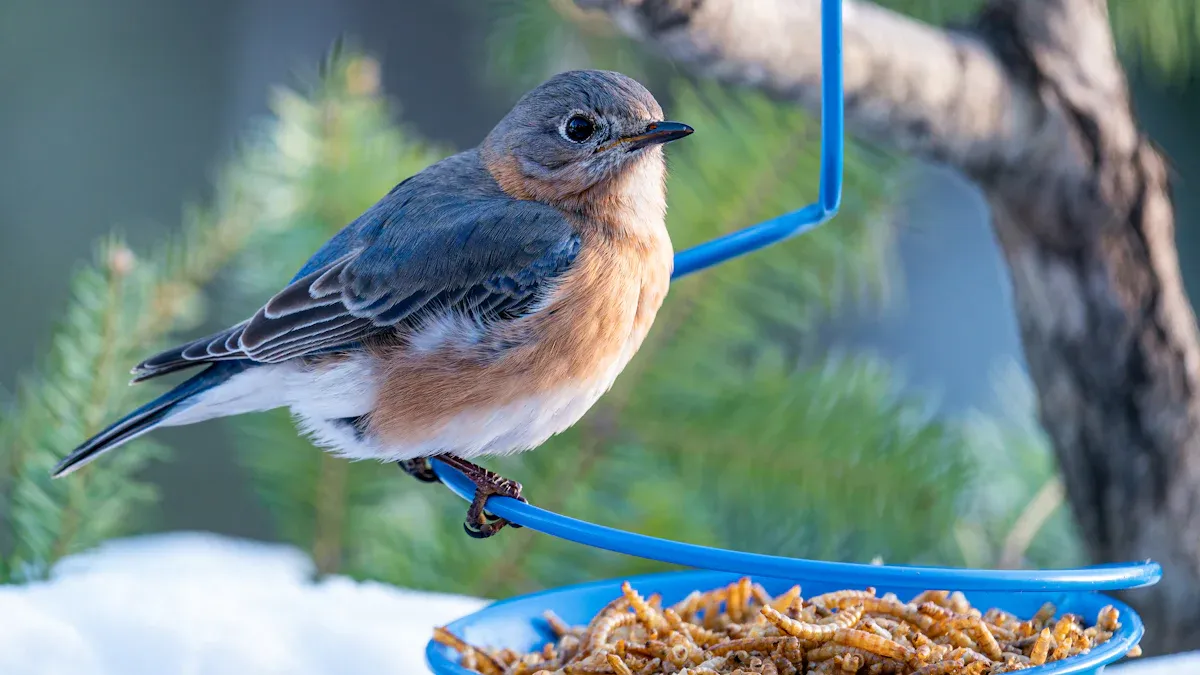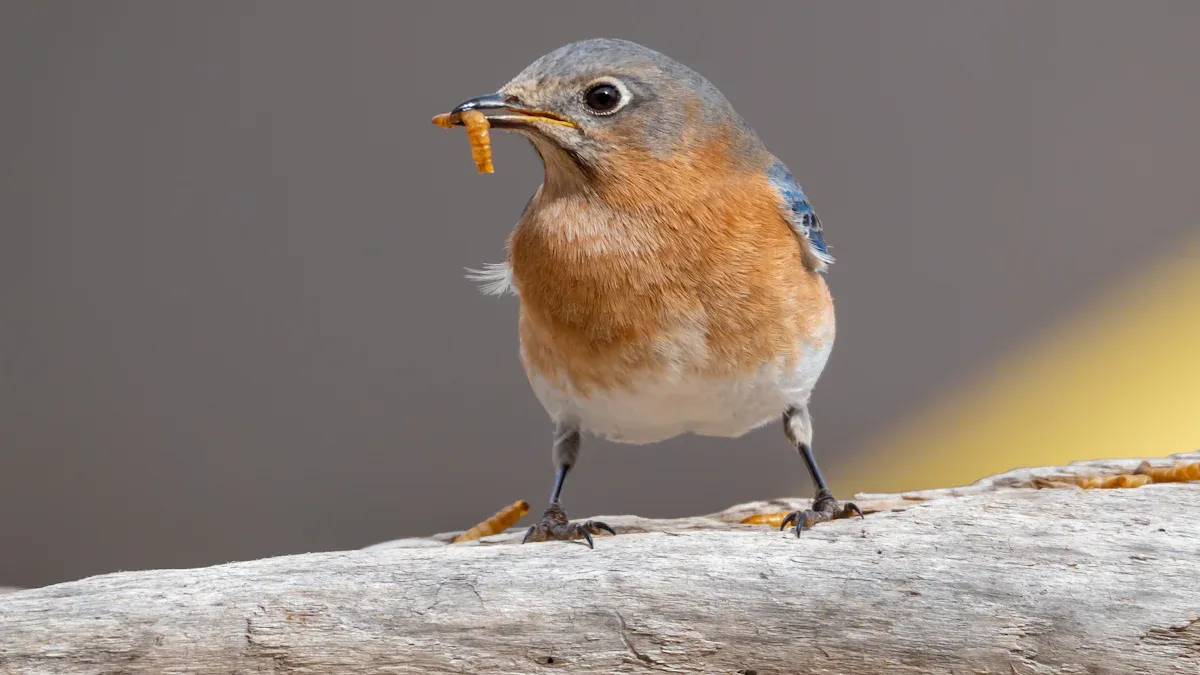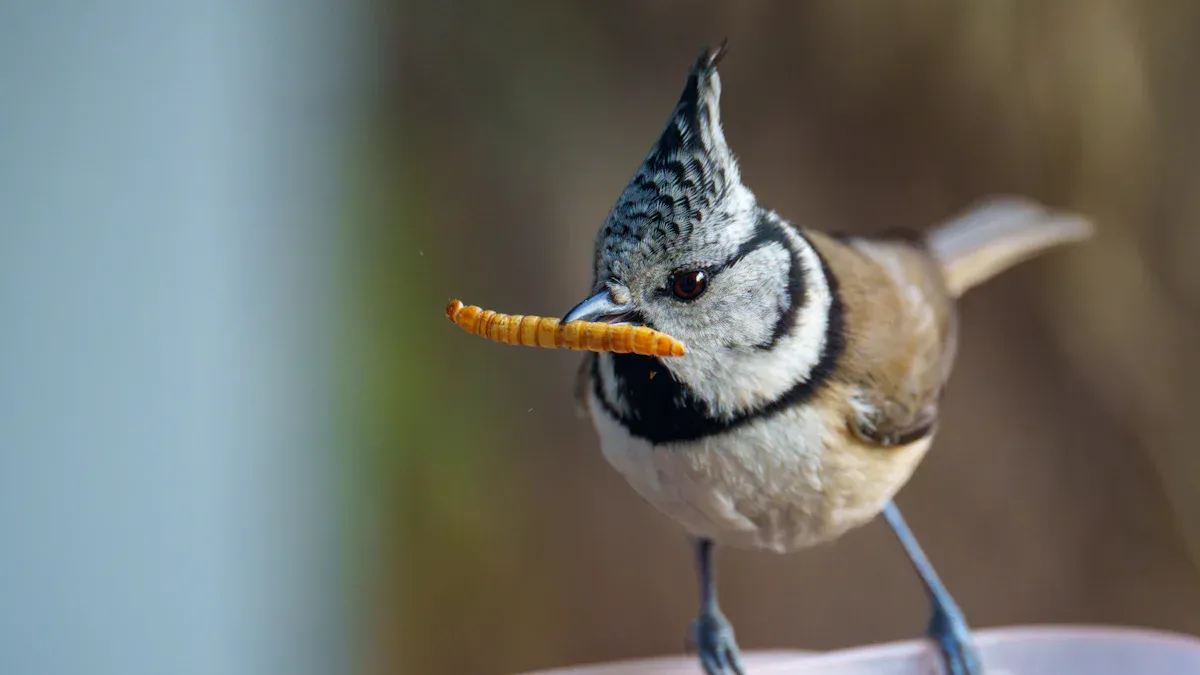
Wild birds need energy-packed food to thrive, and dried mealworms deliver just that. These tiny treats offer an impressive nutritional profile, including 53% protein, 28% fat, and 8.5% carbohydrates. Their balanced mix of nutrients supports bird health and attracts vibrant species like robins, bluebirds, and chickadees. Plus, dried mealworms to wild birds are easy to serve, making them a favorite for bird lovers everywhere.
キーテイクアウト
- Dried mealworms are full of protein, giving birds energy to grow and live.
- These healthy snacks bring many birds, like robins and bluebirds, to your yard.
- Dried mealworms are simple to keep and feed, so they’re great for bird lovers anytime.
Nutritional Benefits of Dried Mealworms to Wild Birds

エネルギーと成長のための高いタンパク質含有量
Protein is a powerhouse nutrient for wild birds. It fuels their energy needs and supports essential growth processes. Dried mealworms are packed with protein, making them an excellent choice for birds that need a quick energy boost.
- Protein helps birds develop strong muscles, which are vital for flying and foraging.
- It plays a key role in feather growth, ensuring birds stay warm and protected.
- During winter and breeding seasons, when energy demands soar, the high protein content in dried mealworms becomes even more critical.
By offering dried mealworms to wild birds, you provide them with the building blocks they need to thrive, especially during challenging times.
Rich in Fats for Sustained Energy
Fats are another essential nutrient found in dried mealworms. They provide birds with long-lasting energy, which is crucial for their daily activities. Whether they’re flying long distances, searching for food, or staying warm in cold weather, birds rely on fat reserves to keep going.
Dried mealworms are an excellent source of healthy fats. These fats help birds maintain their energy levels throughout the day. For species like robins and bluebirds, which are frequent visitors to gardens, this sustained energy can make all the difference in their survival and well-being.
Balanced Nutrition with Vitamins and Minerals
Beyond protein and fats, dried mealworms offer a balanced mix of vitamins and minerals. These nutrients play a vital role in keeping wild birds healthy and active. For example, vitamins like B-complex support metabolism, while minerals such as calcium strengthen bones and eggshells.
Feeding dried mealworms to wild birds ensures they get a well-rounded diet. This is especially important for birds that might struggle to find diverse food sources in urban or suburban areas. By providing this nutrient-rich option, you help them stay strong and resilient.
Attracting Diverse Bird Species with Dried Mealworms

Appeals to Insect-Eating Birds
Dried mealworms are a magnet for insect-eating birds. These birds naturally seek out protein-rich insects in the wild, and mealworms are a perfect match for their diet. Species like ovenbirds and wood thrushes are particularly drawn to this nutritious treat.
| 鳥の種 | Percentage Fed on Mealworms |
|---|---|
| Ovenbird | 92% |
| Wood Thrush | 79% |
By offering dried mealworms, bird enthusiasts can attract these insect-loving species to their yards. It’s a simple way to enjoy the beauty of these birds up close while supporting their dietary needs.
Encourages Visits from Rare or Seasonal Birds
Rare or seasonal birds often have specific dietary preferences, and dried mealworms can help meet those needs. During migration, many birds look for high-energy food to fuel their long journeys. Mealworms provide the perfect boost, making your yard a pit stop for these fascinating travelers.
Imagine spotting a bird you’ve never seen before, like a flycatcher or a wren, enjoying a meal in your garden. Providing dried mealworms increases the chances of these unique visitors gracing your space.
Popular Among Garden Birds and Wildfowl
Garden birds and wildfowl love dried mealworms for their high energy content and essential nutrients. These treats are less messy than live mealworms, making them a convenient option for bird lovers. Robins, bluebirds, and even ducks at the local pond will flock to this tasty snack.
Adding dried mealworms to wild birds’ feeding stations ensures a steady stream of feathered friends. It’s a healthier alternative to bread and a great way to support local wildlife.
乾燥食虫の使用の利便性
Long Shelf Life and Easy Storage
Dried mealworms are incredibly practical for bird enthusiasts. Their long shelf life, ranging from 6 to 15 months, makes them a reliable food source for wild birds year-round. Unlike live insects, dried mealworms don’t require refrigeration. Simply store them in a dark, dry place at room temperature, and they’ll stay fresh and ready to use.
| Shelf Life | Storage Requirements |
|---|---|
| 6 – 15 months | Keep in the dark, dry, and at room temperature |
This convenience means bird lovers can stock up without worrying about spoilage. Whether it’s summer or winter, dried mealworms remain a dependable option for feeding wild birds.
Simple to Handle and Serve
Handling dried mealworms is a breeze compared to live insects. They’re clean, odorless, and won’t crawl out of feeders, making them ideal for anyone who finds live food unpleasant. Many bird enthusiasts appreciate how easy they are to manage, especially when filling feeders or scattering them in the yard.
- Dried mealworms are cost-effective and simple to transport.
- They eliminate the hassle of dealing with wriggling insects.
These qualities make dried mealworms a favorite among bird lovers who want a fuss-free feeding experience.
Versatile for Different Feeding Methods
Dried mealworms offer flexibility in how they’re served. They can be placed in feeders, scattered on the ground, or mixed with other bird foods. This versatility allows bird enthusiasts to cater to different species’ preferences. For example, robins and bluebirds enjoy mealworms on open trays, while chickadees and nuthatches prefer them in hanging feeders.
| Feature | コンテンツ |
|---|---|
| Nutritional Value | High in protein, fat, and potassium, helping birds maintain energy. |
| Attracts Various Birds | Attracts bluebirds, chickadees, titmice, nuthatches, warblers, and more. |
| Storage Convenience | Does not require refrigeration and has a long shelf life. |
| Ease of Use | Easy to feed; they won’t crawl out of the feeder. |
| Year-Round Use | Can be used throughout the year. |
| No Additives | 100% naturally dried, additive and preservative free. |
This adaptability makes dried mealworms a versatile and effective choice for feeding wild birds, ensuring a steady stream of feathered visitors to your yard.
Seasonal Support for Wild Birds
Essential Nutrition During Breeding Season
Breeding season is a critical time for wild birds. Parent birds need energy to care for their young, while nestlings require nutrients to grow strong and healthy. Dried mealworms to wild birds provide the perfect solution during this demanding period.
- Packed with protein, they support muscle and feather development in growing chicks.
- They offer a convenient food source for parent birds, reducing the time spent searching for insects.
- Their high nutritional value makes them a gourmet treat, ensuring birds get the best possible start in life.
Adding dried mealworms to feeding stations during breeding season helps birds thrive. It’s a simple way to support their growth and survival.
Energy Boost for Harsh Winters
Winter can be tough for wild birds. Food becomes scarce, and cold temperatures drain their energy reserves. Dried mealworms offer a reliable source of calories to help birds stay warm and active.
These protein-rich treats are easy to store and serve, making them ideal for winter feeding. Birds like robins and chickadees flock to mealworms for the energy they need to survive freezing nights. By providing dried mealworms, bird lovers can make a big difference during the harshest months of the year.
Aids in Migration Preparation and Recovery
Migration is one of the most challenging times for wild birds. They travel long distances, often crossing ecological barriers like seas or deserts. Dried mealworms simulate natural refueling opportunities, helping birds prepare for their journey and recover afterward.
| Key Findings | コンテンツ |
|---|---|
| 食品の種類 | Mealworms simulate natural refueling opportunities for migratory birds. |
| Energy Reserves | Birds crossing large ecological barriers, like the Mediterranean Sea, require replenishment of energy reserves. |
| Food Availability | The amount of food influences the behavior and energy accumulation of migratory birds during stopovers. |
| Conservation Implications | Protecting stopover habitats with sufficient food resources is crucial for the survival of birds in poor condition. |
Providing dried mealworms during migration seasons ensures birds have the energy they need to complete their journey. It also supports conservation efforts by offering a reliable food source at stopover points.
Enhancing Bird Health and Behavior
Boosts Immune System and Reduces Stress
Wild birds face countless challenges in their environment, from predators to harsh weather. A strong immune system helps them stay healthy and resilient. Dried mealworms to wild birds provide essential nutrients like protein and fats, which play a key role in boosting immunity. These nutrients help birds fight off infections and recover faster from injuries.
Stress is another factor that affects bird health. When food is scarce, birds often experience stress, which weakens their immune systems. Offering dried mealworms ensures a reliable food source, reducing stress and helping birds maintain their natural energy levels.
ヒント: Place dried mealworms in feeders during early mornings or late afternoons when birds are most active. This timing ensures they get the nutrition they need to start or end their day strong.
Encourages Natural Foraging Instincts
Birds are natural foragers. They love searching for food, whether it’s hidden in tree bark or scattered on the ground. Dried mealworms mimic the insects birds would typically find in the wild, encouraging them to use their natural instincts.
Scattering dried mealworms around your yard or garden creates a fun and enriching environment for birds. They’ll hop, peck, and explore as they search for these tasty treats. This activity keeps them physically active and mentally stimulated, which is essential for their overall well-being.
For bird enthusiasts, watching this behavior can be a delightful experience. It’s a chance to observe birds up close as they interact with their surroundings in a natural way.
Improves Feather Quality and Appearance
Feathers are more than just a bird’s outer covering. They’re essential for flight, insulation, and even attracting mates. High-quality feathers require proper nutrition, and dried mealworms deliver just that.
The protein in dried mealworms supports feather growth and repair. Birds with strong, healthy feathers can fly more efficiently and stay warm during colder months. Additionally, vibrant, well-maintained feathers make birds more attractive to potential mates during breeding season.
| 食事の種類 | Nutritional Value | Moisture Content | Impact on Nestlings |
|---|---|---|---|
| Dried Mealworms | Low | Little to None | Potentially Injurious |
| Live Mealworms | Higher | Moisture-Rich | Beneficial |
While live mealworms offer more moisture, dried mealworms are still an excellent option for adult birds. They provide the nutrients needed to maintain feather quality without the hassle of handling live insects.
お問い合わせ: Regularly offering dried mealworms can help birds look their best while supporting their health and survival.
Feeding dried mealworms to wild birds is a simple yet impactful way to support their health and behavior. These protein-packed treats attract a variety of species, making your yard a lively haven for birdwatching. By adding dried mealworms to wild birds’ diets, you help them thrive while enjoying their vibrant presence year-round.
よくある質問
どんな種類の鳥が乾燥した食事虫を食べますか?
Dried mealworms attract insect-eating birds like robins, bluebirds, chickadees, and woodpeckers. They also appeal to seasonal visitors like wrens and flycatchers.
How should dried mealworms be served?
Place them in feeders, scatter them on the ground, or mix them with seeds. Birds like robins prefer open trays, while chickadees enjoy hanging feeders.
ヒント: Soak dried mealworms in water for added moisture, especially during hot summers or breeding seasons.
Can dried mealworms replace a bird’s natural diet?
No, they should complement a bird’s diet. Birds need a variety of foods, including seeds, fruits, and insects, to stay healthy and active.


